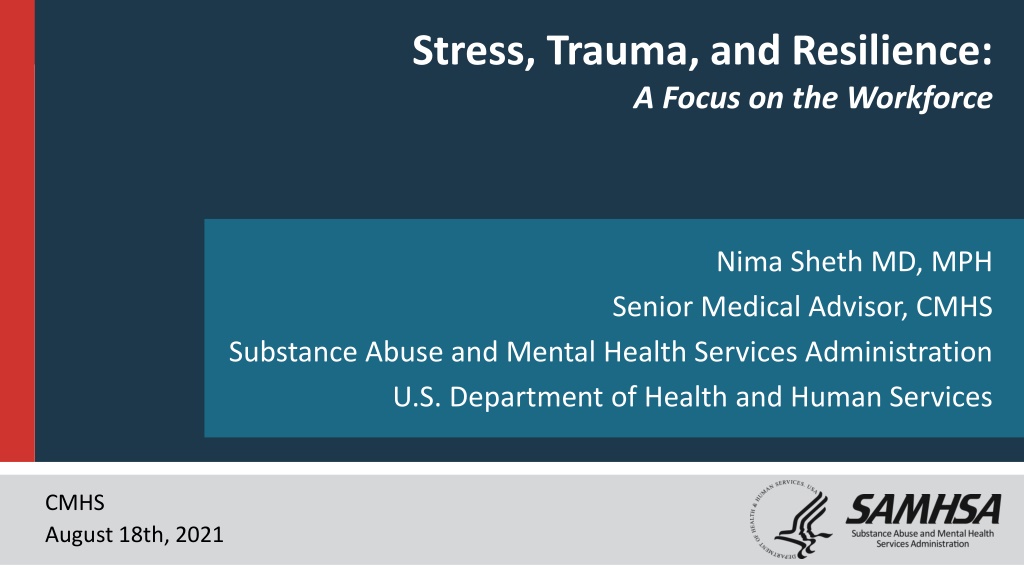Understanding Stress, Trauma, and Resilience in the Workforce
This presentation delves into stress, trauma, and resilience in the workforce, highlighting the impact on individuals' mental health and well-being. It discusses the adaptive nature of stress responses, the effects of trauma on core areas such as self-esteem and trust, and the challenges faced by providers dealing with guilt, grief, anxiety, and helplessness. The content emphasizes the importance of recognizing signs of stress, addressing stigma, and coping with moral conflicts in professional settings.
Download Presentation

Please find below an Image/Link to download the presentation.
The content on the website is provided AS IS for your information and personal use only. It may not be sold, licensed, or shared on other websites without obtaining consent from the author. Download presentation by click this link. If you encounter any issues during the download, it is possible that the publisher has removed the file from their server.
E N D
Presentation Transcript
Stress, Trauma, and Resilience: A Focus on the Workforce Nima Sheth MD, MPH Senior Medical Advisor, CMHS Substance Abuse and Mental Health Services Administration U.S. Department of Health and Human Services CMHS August 18th, 2021
Stress and Stress Response An adaptive response to an environmental stimulus that enhances survival, development and function Not just an emergency response but an ongoing process of adaptation Mild stress improves performance=beneficial Higher stress impedes performance Severe stress can be toxic (can cause fear conditioning) Good Stress~Bad Stress 3 Slide from Akil, 2021
We are all Fragile and Resilient 4 Slide from Akil, 2021
Core Areas Impacted by Trauma Feelings of helplessness/sense of control Intimacy Self esteem Safety Trust *Historical/Intergenerational Trauma (Resick et al, 2017) 7
Guilt from fear of illness, not doing more, not wanting to work; lack of empathy Grief over multiple losses Anxiety about your or your loved one s health Helplessness loss of control; reduced functioning Sources & Signs of Stress Confidence Level Drops Anger about the possibility of being put in danger Adapted from: https://www.thesch wartzcenter.org/me dia/Schwartz- Center-Watson-SFA- Final-PDF.pdf Stigma & Lack of Resources Demoralization
We may perpetrate, fail to prevent, or witness events that contradict moral beliefs Acting or witnessing behaviors that go against our values and moral beliefs Under different circumstance s, a person s life may have been saved Life and death triage or resource decisions Betrayal from leadership, others in power or peers Not being able to save a particular patient Work duties affecting one s family MORAL INJURY Guilt, shame, disgust and anger Survivor Guilt Not Feeling Powerless Compassio n Fatigue May Affect Spirituality wanting to work
Resilience: Multiple Interacting Systems From molecules to culture 11 Slide from Akil, 2021
What Is Resilience The ability to bend but not break Is it a trait? A process? An outcome? Does it cross domains? Is it static or dynamic? The capacity of a dynamic system to adapt successfully to disturbances that threaten the viability, function or development of that system (Masten et al 2014) 12 Slide from Akil, 2021
Resilience 13 Slide from Akil, 2021
Vicarious Trauma Emotional lability/ numbness Feelings of isolation, demoralization, or apathy Difficulty sleeping Somatic symptoms Irritability/ aggressive behaviors Conflict with loved ones Trauma symptoms (hypervigilance, avoidance, destructive behaviors) 16






























